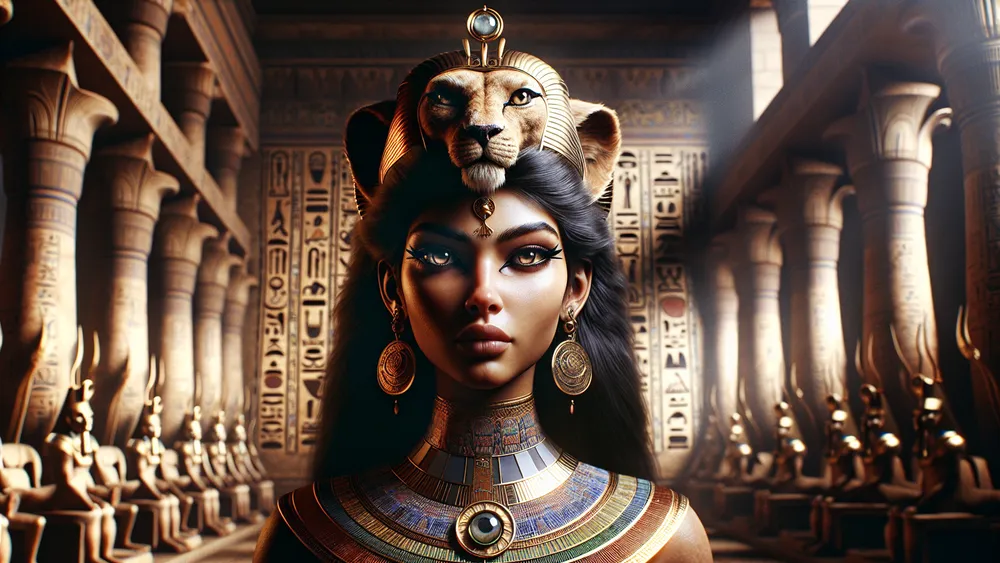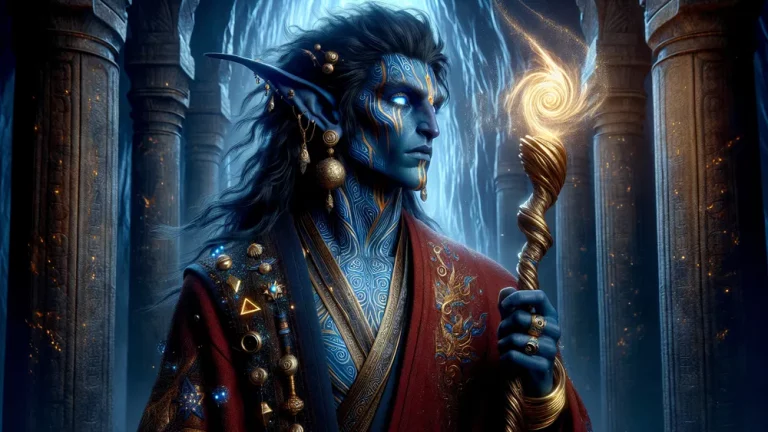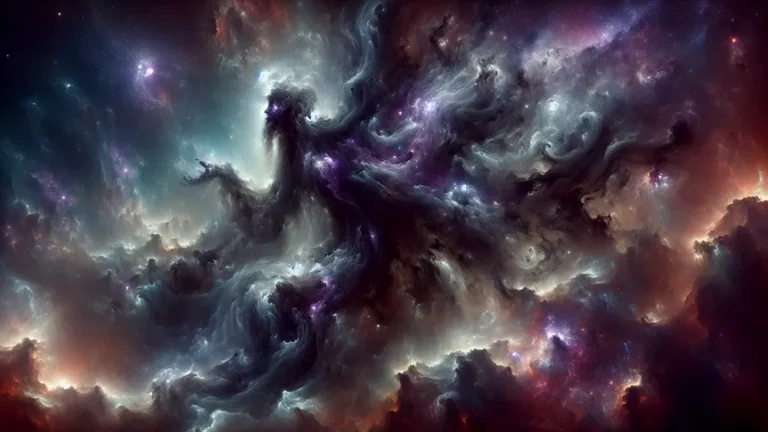Wadjet: Protector Goddess And Ancient Symbol
Wadjet, an ancient Egyptian goddess, plays a big role in Egyptian mythology. She’s mainly known as a protector deity and often shows up as a cobra, which stands for her fierce and watchful nature. Her impact goes beyond just myths; it touches many parts of ancient Egyptian life, like art, religion, and royal symbols.
Key Points:
- Wadjet, an ancient Egyptian goddess, is known for her protective nature and is often symbolized as a cobra.
- Her name Wadj means green, symbolizing fertility and vegetation.
- Wadjet plays a crucial role in Egyptian history, especially in protecting pharaohs and maintaining cosmic balance.
- The cobra symbol represents Wadjet’s protection and sovereignty in ancient Egyptian culture.
- Wadjet’s influence transcends time, appearing in modern media, art, and fashion.
- Her symbol, especially the cobra, is widely used in contemporary products and designs, reflecting themes of protection and power.
- Wadjet’s significance in modern culture lies in her representation as a protective and historically rooted symbol.
In this blog post, we’re diving into her origins, historical importance, protective roles, and the lasting symbols of Wadjet. We want to show how this ancient goddess still grabs our attention today. By looking closely at her name, history, and how she appears in both old and new media, we hope to give you a full picture of Wadjet’s lasting story.
The Origins of Wadjet
To really get why Wadjet matters, we need to dive into where she comes from and what her different names and titles mean. Let’s break it down and see how it all connects.
Etymology of Wadjet
Wadjet’s name comes from the Egyptian word “wadj,” which means “green.” This ties her to the color green and fertility. Green stands for growth, plants, and life itself. People also call her by different names that show off her many sides. For example, she’s known as “The Green One,” which highlights her link to plants and life.

Another name is “Lady of Flame,” possibly pointing to her fierce and protective nature. These names change depending on where you are in ancient Egypt, showing how people worshipped her in various ways.
- “Wadj” meaning “green”: Symbolizes fertility and vegetation.
- “The Green One”: Emphasizes her connection to growth and life.
- “Lady of Flame”: Highlights her protective and possibly fierce nature.
- Regional variations: Different names and titles used in various parts of ancient Egypt.
Wadjet’s names and titles reflect her associations with fertility, growth, and protection, which vary across different regions in ancient Egypt.
Historical Significance of Wadjet
So, now that we know where Wadjet comes from and what her names mean, let’s see how she fits into ancient Egyptian history. She plays a big part in their culture and daily life. Ready to dive in? Let’s explore her influence on everything from pharaohs to art.
Wadjet in Ancient Egyptian History
Wadjet plays a big role in early Egyptian mythology. She’s mainly linked with Lower Egypt. As a cobra goddess, she stands for protection and royal power. You often see her as a rearing cobra, ready to strike at enemies. Her influence runs deep in Egyptian culture and society. People venerate her as the protector of pharaohs.
This protection shows up visually with the uraeus, which is a special upright form of an Egyptian cobra, worn on the pharaoh’s crown. In art and hieroglyphs, you frequently see Wadjet alongside other deities. This emphasizes her importance in the divine world and her protective role over the nation.

- Uraeus on Pharaoh’s Crown: Symbol of Wadjet’s protection.
- Depictions in Art: Often shown as a cobra or with other deities.
- Hieroglyphs: Used to represent her name and attributes.
- Lower Egypt: Region most closely associated with her worship.
Wadjet as a Protector
Wadjet’s role as a guardian goes beyond just her symbolic presence in art and hieroglyphs. Let’s dive into how she protects pharaohs and other deities in ancient Egyptian mythology.
Protector of Pharaohs and Deities
Wadjet really stands out as a guardian of the pharaohs. You often see her on the pharaoh’s crown, depicted as the uraeus, which is an upright cobra ready to strike. This symbol shows her protective nature and her divine authority over Egypt.
There are stories about how she protects pharaohs in battles, using her venomous bite to fend off enemies and ensure victory. But she doesn’t just protect pharaohs; she also looks out for other deities. She’s closely linked with gods and goddesses like Horus and Isis. You often see her in myths alongside them.
These stories highlight her protective powers, showing how she uses her abilities to shield other deities from harm and keep everything in balance.
- Uraeus: Symbol worn on the pharaoh’s crown representing Wadjet.
- Battle Protection: Stories of Wadjet defending pharaohs in combat.
- Association with Horus and Isis: Depictions in art and mythology.
- Cosmic Order: Role in maintaining balance and safety among deities.
Wadjet’s role as a protective guardian for pharaohs and other deities, particularly her association with Horus and Isis, and her use of venomous bite in battles to maintain cosmic balance and order.
Symbolism and Iconography of Wadjet
We know Wadjet protects, but how do the ancient Egyptians show this? Let’s dive into the symbols and icons that represent her.
The Cobra Symbol
The cobra, a symbol of Wadjet, really stands out in Egyptian art and culture. You often see it as an upright, rearing serpent on the pharaoh’s crown, called the uraeus. This shows royal authority and divine protection. In Egyptian culture, the cobra means protection, sovereignty, and fierce power. It reflects Wadjet’s role as a guardian.
You find the cobra symbol in all sorts of artifacts like jewelry, amulets, and statues. For example, people wore cobra-shaped amulets to protect themselves from evil. Statues of Wadjet often show her as a cobra to highlight her protective nature. Depending on the context, the cobra can mean different things.
Sometimes it stands for fertility and renewal, while other times it means defense and aggression.
| Artifact Type | Description | Significance |
|---|---|---|
| Jewelry | Cobra-shaped pendants and earrings | Worn for protection and as a status symbol |
| Amulets | Small cobra figures | Believed to ward off evil and provide safety |
| Statues | Sculptures of Wadjet in cobra form | Emphasize her role as a protector goddess |
| Hieroglyphs | Cobra symbols in writing | Represent divine authority and protection |
The cobra symbol in Egyptian culture represents protection, sovereignty, and divine power, often featured in various artifacts and symbolizing different meanings like fertility and defense.
Wadjet in Modern Media
Wadjet’s story doesn’t just stay in the past. She pops up in today’s culture too. Let’s dive into how she shows up in books, movies, and even art.
Representation in Contemporary Culture
Wadjet pops up quite a bit in modern books and movies. You see her in “The Kane Chronicles” by Rick Riordan, where she’s this powerful, protective goddess. In films, especially ones about ancient Egypt like “The Mummy” series, her symbolism is all about protection and mystery. And it doesn’t stop there. Her iconic cobra form shows up in modern art and fashion too. Artists and designers love using her image to create eye-catching pieces.
People really go for Wadjet-themed jewelry, like cobra-shaped necklaces and bracelets. They’re not just pretty; they carry a piece of history with them.

- Books: “The Kane Chronicles” by Rick Riordan
- Movies: “The Mummy” series
- Jewelry: Cobra-shaped necklaces and bracelets
- Art: Contemporary designs featuring Wadjet’s cobra form
Other Uses of Wadjet’s Symbol
Wadjet’s influence isn’t just in books and art; it pops up in all sorts of modern products too. Let’s dive into how her symbol shows up today.
Wadjet in Modern Products
Wadjet’s symbol, especially the cobra, pops up everywhere in today’s products. You see it in jewelry, home decor, and fashion items. People love cobra-shaped necklaces, bracelets, and rings for their cool look and historical vibe. In home decor, you find wall art, sculptures, and decorative vases with Wadjet’s imagery, giving a touch of ancient Egypt to modern homes.

Fashion designers also get creative with Wadjet’s symbol in clothing and accessories, making unique and stylish pieces. The fascination with ancient Egyptian heritage drives the demand for these Wadjet-themed products. They often highlight themes of protection, power, and fertility, which connect her ancient roles to what we value today.
- Jewelry: Cobra-shaped necklaces, bracelets, rings
- Home Decor: Wall art, sculptures, decorative vases
- Fashion Items: Clothing and accessories featuring Wadjet’s imagery
- Themes: Protection, power, fertility
Pantheon of Egyptian Mythology Gods
The pantheon of Egyptian mythology is vast and intricate, featuring a multitude of gods and goddesses each with unique roles and stories. For a comprehensive overview, you can explore this list of all the Egyptian gods.
FAQs
1. Who was Wadjet in Egyptian mythology?
Wadjet in Egyptian mythology was a goddess associated with protection, often depicted as a cobra and linked to the pharaohs and Lower Egypt.
2. What does the cobra symbolize in relation to Wadjet?
The cobra symbolizes Wadjet’s role as a protector and guardian in ancient Egyptian mythology.
3. How was Wadjet depicted in ancient Egyptian art?
Wadjet was depicted in ancient Egyptian art primarily as a cobra, often shown rearing up with a flared hood.
4. What is the significance of Wadjet in modern culture?
The significance of Wadjet in modern culture lies in her continued representation in art, fashion, and media, symbolizing protection and connection to ancient Egyptian heritage.







